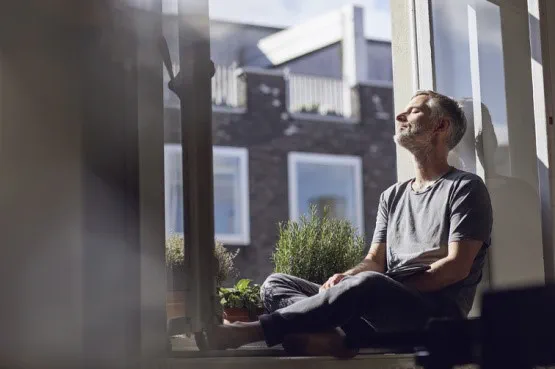Looking after your mental health throughout the winter
The change in seasons can be a difficult time for many people. Darker nights and a drop in temperature can affect how you feel. If you find the colder months hard, here are some simple ways you can look after your mental health.

Why might my mental health get worse in the winter?
There are several reasons why your mood may be low during winter.
1. Change can be hard to manage
Even though a new season is a predictable change, it’s still a change. And any type of change can be challenging. With change comes uncertainty, which can be a lot for your body and mind to cope with.
2. Change can create a feeling of loss
Any change (positive or negative) can cause stress, and change is typically associated with the loss of something. For example, by moving into the autumn, you lose the longer daylight hours.
3. Physical changes
The changes in temperature and fewer hours of sunlight could affect your mood. It’s thought that the short winter days and fewer hours of daylight might disrupt your body’s internal clock. This disruption affects the production of melatonin, a hormone that regulates your sleep patterns. When your sleep patterns are disturbed, this can affect your health and mood.
How can I improve my mood in winter?
Recognise the signs of winter depression
It’s not uncommon for your mood to dip in winter. But if it’s affecting your day-to-day life and happens with the change of the season, you might have seasonal affective disorder (SAD).
SAD is a form of depression that commonly happens in the winter, with the symptoms easing in spring or summer. But SAD can affect you at any time of year.
If you recognise any of the following signs, it may be worth considering taking some action to help bring some balance back to your mood.
- Having low energy.
- Finding it difficult to concentrate.
- Not wanting to spend time with others.
- Changes in appetite (feeling more or less hungry than usual).
- Feeling sad or low, or becoming more tearful than usual.
- Being more likely to get physical health problems, such as having a cold.
- Loss of interest in things.
- Suicidal feelings or thoughts.
Set and keep to a schedule as much as possible
The more change that’s happening, the more important it can become to stick to a regular routine. Having some things that are predictable in your time can create a sense of stability and help you feel more in control.
Planning activities that make you feel happy, connected to others, and give a sense of achievement can help to boost your mood.
Make the most of the daylight
Exposure to light is important during the shorter daylight hours. Getting more light can help improve symptoms of seasonal affective disorder (SAD). You could try using a light box to help with this – this is lamp that mimics natural light.
Be creative with how you get more light. You could try brightening up your home environment by opening curtains and blinds, to let in as much sunlight as possible. Or schedule some time to get outside when you can during the day.
Be proactive
Take charge of what you’re experiencing either to prevent things from getting worse, or from happening in the first place. Be proactive with your exercise and diet by ensuring you make time for physical activity and for eating well.
Exercise is known to decrease symptoms of depression and this doesn’t have to mean going out on a two-hour run. Simply walking around the block can help.
If you’re not sure what to do that might boost your mood and mental health, it can sometimes help to keep a journal (either on paper or using an app on your phone).
Through journaling, you can pick up on any patterns about what makes you feel better, and what makes you feel worse. Then you can plan ahead and make sure you can do the things you enjoy, or limit activities that lower your mood.
Be kind to yourself
It’s normal to experience a change of mood when things in life change. But remember, it’s how we respond to these changes that can make a difference. Try to go easy on yourself and show yourself the same kindness and compassion as you would to others.
As the days become shorter, you could try to embrace the benefits of a change in the season and enjoy being cosy at home. The Scandinavian concept of hygge aims to make you feel content and comfortable, which can be a remedy to those long winter nights.
You can bring hygge into your life by slowing down and enjoying life’s simple pleasures. Why not create a cosy mood at home by using scented candles or fairy lights?
A warm mug of tea, cocoa, or soup can be soothing, as can a hot bubble bath. Layering up with your favourite blanket or chunky jumper is another way to self-soothe.
Seek support
If your symptoms persist, or if you’re finding it hard to manage or cope on your own, speak to your friends, family, or GP. If you don’t feel comfortable doing that, you can visit the Mind website for more information or call the Samaritans helpline (116 123) in confidence.
If you’re worried about your mental health, our direct access service aims to provide you with the advice, support and treatment you need as quickly as possible. You’ll be able to get mental health advice and support usually without the need for a GP referral. Learn more today.
-
Sources Sources
- Change, loss and bereavement. Mental Health Foundation. mentalhealth.org.uk, accessed 20 September 2023
- Shawa N, Rae DE, Roden LC. Impact of seasons on an individual’s chronotype: current perspectives. Nat Sci Sleep 2018;10:345-354. DOI:10.2147/NSS.S158596
- Mattingly SM, Grover T, Martinez GJ, et al. The effects of seasons and weather on sleep patterns measured through longitudinal multimodal sensing. NPJ Digit Med 2021;4:76. DOI: 10.1038/s41746-021-00435-2
- Tordjman S, Chokron S, Delorme R, et al. Melatonin: Pharmacology, Functions and Therapeutic Benefits. Curr Neuropharmacol 2017;15:434-443. DOI: 10.2174/1570159X14666161228122115
- Seasonal affective disorder (SAD) – about SAD. Mind. mind.org.uk, published April 2022
- Seasonal affective disorder – summary. BMJ Best Practice. bestpractice.bmj.com, last reviewed 21 August 2023
- Seasonal affective disorder (SAD). Mental Health Foundation. mentalhealth.org.uk, last updated 15 February 2022
- 12 tips for coping with change. British Heart Foundation. bhf.org.uk, accessed 21 September 2023
- Seasonal affective disorder – approach. BMJ Best Practice. bestpractice.bmj.com, last reviewed 21 August 2023
- Campbell PD, Miller AM, Woesner ME. Bright Light Therapy: Seasonal Affective Disorder and Beyond. Einstein J Biol Med 2017;32:E13-25
- Seasonal affective disorder (SAD) – self-care. Mind. mind.org.uk, published April 2022
- Singh B, Olds T, Curtis R, et al. Effectiveness of physical activity interventions for improving depression, anxiety and distress: an overview of systematic reviews. Br J Sports Med 2023 (epub ahead of print). DOI:10.1136/bjsports-2022-106195
- Hygge. Merriam-Webster. merriam-webster.com, accessed 21 September 2023
- What do we mean by “hygge”? Ministry of Foreign Affairs Denmark. denmark.dk, accessed 21 September 2023
About our health information
At Bupa we produce a wealth of free health information for you and your family. This is because we believe that trustworthy information is essential in helping you make better decisions about your health and wellbeing.
Our information has been awarded the PIF TICK for trustworthy health information. It also follows the principles of the The Information Standard.

More mental health and wellbeing articles
Did you find our advice helpful?
We’d love to hear what you think. Our short survey takes just a few minutes to complete and helps us to keep improving our healthy lifestyle articles.
Legal disclaimer
This information was published by Bupa's Health Content Team and is based on reputable sources of medical evidence. It has been reviewed by appropriate medical or clinical professionals and deemed accurate on the date of review. Photos are only for illustrative purposes and do not reflect every presentation of a condition.
Any information about a treatment or procedure is generic, and does not necessarily describe that treatment or procedure as delivered by Bupa or its associated providers.
The information contained on this page and in any third party websites referred to on this page is not intended nor implied to be a substitute for professional medical advice nor is it intended to be for medical diagnosis or treatment. Third party websites are not owned or controlled by Bupa and any individual may be able to access and post messages on them. Bupa is not responsible for the content or availability of these third party websites. We do not accept advertising on this page.







